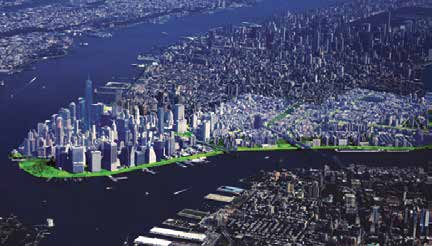
The feds recently pledged $176 million for storm-resiliency projects meant to protect Lower Manhattan from the Lower East Side to the northern tip of Battery Park City but that money won’t be nearly enough.
BY YANNIC RACK |
The $176 million the federal government recently pledged to fund storm-resiliency projects in Lower Manhattan is just a trickle, not a flood, considering the overall cost of the ambitious plans.
This month, the federal government awarded the funds for ambitious storm protections to run from Montgomery St. on the Lower East Side to the northern tip of Battery Park City, fortifying one of the most vulnerable stretches of shoreline in the city.
But with the project expected to cost at least $600 million, the recent federal contribution is just a drop in the bucket, leaving the vital project largely unfunded until hundreds of millions of dollars in additional funding can be found, though city officials said that initial work will begin with what funds are available.
“Mother Nature will not wait for politicians to figure how to secure our waterfront,” said Catherine McVay Hughes, who has long advocated for resiliency measures Downtown as chairwoman of Community Board 1.
The city had actually applied for $500 million for the project — called Lower Manhattan Protect and Connect — through a competition by the U.S. Dept. of Housing and Urban Development, so the $176-million award leaves the project more than $300 million short, even with the $115 million in city and state funds already pledged to the effort.
Hughes said the award was great news, but that the process was still moving too slow, especially considering the havoc wreaked by Sandy, which killed over 50 people and caused at least $18 billion in damage across the city. “Anything you do on the waterfront has to be carefully orchestrated,” she said.
Even more modest projects that are already fully funded will take a long time to come to fruition. The so-called East Side Coastal Resiliency Project, spanning the Lower East Side shoreline from Montgomery St. north to E. 23rd St., was awarded $335 million through a separate federal competition two years ago.
Since then, preliminary designs have been completed, according to city officials, but work won’t start until mid-2017, and won’t be complete until 2022. Last October, the city put out a request for proposals to find an engineering partner for the Lower Manhattan Protect and Connect project, according to officials familiar with the plans, but work won’t begin for several more years.
Although specific plans are not finalized, the expectation is that most of Lower Manhattan will eventually be protected from storm surges by a system of sea walls, movable flood barriers, pumps, and a levee system its southern tip.
Proposals also call for flood-proofing public housing developments, and integrating the water barriers into plazas, parks and retail areas. The mayor and city officials have emphasized that sections of both projects will go online before all of the work is completed, but Downtowners are eager to finally see results.
“The anxiety is there until protection is in place,” said state Sen. Daniel Squadron. After Sandy flooded subways and swamped apartment houses and office buildings in Lower Manhattan, architects and engineers came up with a comprehensive flood prevention system for a continuous 10-mile stretch of shoreline, spanning all the way from West 57th St. south to The Battery and up to East 42th St.
This “Big U” design of barriers and berms was drawn up for the first federal competition but only represented a concept, according to the city. The current two proposals, which complement each other, cover less of the island — Battery Park City is included in the city’s RFP for Lower Manhattan Protect and Connect, but Tribeca is not.
“We had to fight to make sure that even Battery Park City was included,” said Hughes, adding that the city now needs to start implementing real measures. “A line on paper is going to get you nowhere when there’s rising tides.” For some Downtown residents, the need for flood protection came into sharp focus once again when historic snowfall from last weekend’s winter storm raised the water level in Lower Manhattan.
Marco Pasanella, a Sandy survivor who lives near the waterline on South St., said he was nervously watching the river over the weekend. “The whole beach under the Brooklyn Bridge was submerged on Saturday,” he said later. “It just reminds you, ‘Oh my god, not this again.’ It was scary.”
When Sandy struck, the wine store he runs on the building’s ground floor was flooded with more than six feet of water. Pasanella said the high tide over the weekend came within just a few inches of breaching the pier bulkhead in the Seaport, which would once again have sent water cascading into the street.
“It reminds me, as excited as I am about the long term prospects of this money, we’re just s— out of luck right now,” Pasanella said. “It’s almost four years after Sandy, and I’m just as vulnerable as I was the day before.”

















